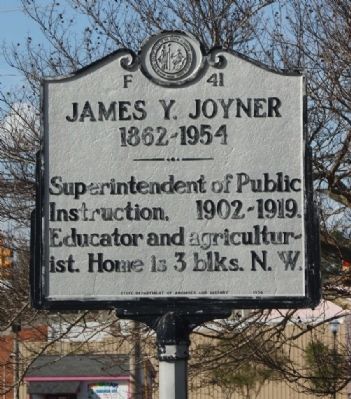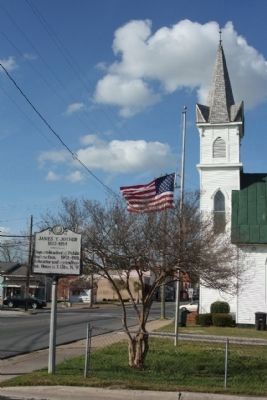La Grange in Lenoir County, North Carolina — The American South (South Atlantic)
James Y. Joyner
1862-1954
Erected 1970 by State Department of Archives and History. (Marker Number F-41.)
Topics and series. This historical marker is listed in these topic lists: Agriculture • Education. In addition, it is included in the North Carolina Division of Archives and History series list.
Location. 35° 18.293′ N, 77° 47.352′ W. Marker is in La Grange, North Carolina, in Lenoir County. Marker is on South Caswell Street (State Highway 903) near East Washington Street, on the right when traveling north. Touch for map. Marker is in this post office area: La Grange NC 28551, United States of America. Touch for directions.
Other nearby markers. At least 8 other markers are within 10 miles of this marker, measured as the crow flies. William Dunn Moseley (approx. half a mile away); Dobbs County (approx. 3.6 miles away); Dobbs County Court House (approx. 3.6 miles away); a different marker also named Dobbs County Court House (approx. 4˝ miles away); The Battle of Whitehall (approx. 6.2 miles away); Engagement at Whitehall (approx. 6.2 miles away); Wheat Swamp Church (approx. 7.8 miles away); Moving the CSS Neuse (approx. 9.8 miles away).
Regarding James Y. Joyner. During the late nineteenth century North Carolina’s educational system had problems dealing with rural populations, transportation, funding, and teacher recruitment. Through the efforts of a group of leaders including Charles B. Aycock, Edwin A. Alderman, Charles D. McIver, and James Y. Joyner, the problems were addressed. Joyner was vitally important to the change of attitude and improved North Carolina’s schools systems first as an instructor and later as an administrator.
James Yadkin Joyner was born during the Civil War and was orphaned at the age of two. He grew up in Lenoir County under the watchful eye of his grandfather, a prominent planter and influential Democrat. Joyner attended a local academy and later the University of North Carolina where he grew close to several up and coming North Carolina political leaders including future governor Aycock. After graduation in 1881, Joyner taught at schools across the state and, by 1889, he had joined Alderman and McIver in providing a traveling educational program for the state’s teachers. Over the next decade Joyner served a series of school systems and colleges as an educator and administrator, including serving as dean for the State Normal and Industrial College in Greensboro, the present University of North Carolina
at Greensboro.
Governor Charles B. Aycock in 1902 appointed Joyner to the position of
State Superintendent of Public Instruction, a position that Joyner would hold for the next seventeen years. As superintendent, Joyner sought to bolster teacher training by encouraging the development of normal schools, improving the curriculum of rural schools by adding specialized classes to improve agriculture and homemaking skills, and increasing the length of the school year from four to six months. Through his work, Joyner raised the profile of the superintendent’s job and increased awareness of the state’s educational needs. Joyner retired from educational pursuits in 1918 and became involved in private business, serving as president of the North Carolina Tobacco Growers Association. He died at the age of ninety-one and was buried beside his wife in Raleigh’s Oakwood Cemetery. (North Carolina Office of Archives & History — Department of Cultural Resources)
Credits. This page was last revised on June 30, 2021. It was originally submitted on July 23, 2013, by Mike Stroud of Bluffton, South Carolina. This page has been viewed 489 times since then and 10 times this year. Photos: 1, 2. submitted on July 23, 2013, by Mike Stroud of Bluffton, South Carolina.

